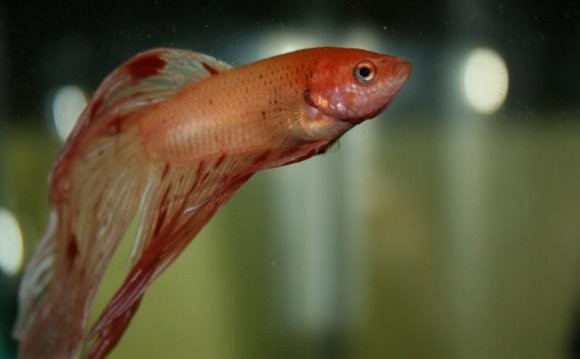
Swimbladder is a disease which symptoms cause fish to become unable to swim correctly, your fish may exibit swimming toward the bottom of your tank or bowl, then floating back up, swimming in circles or laying or floating on his side.
There are three main things according to the posts and articles I've read that can lead to swimbladder disease.
I recommend the following regimine, recommened to me over two years ago.
First If you have your fish in a bowl, and your normal routine consist of 100% water changes, As soon as you notice signs of swimbladder do a complete water change, taking care not to stress the fish by having the water temp as close to his bowl as possible, and using something as a cup so you don't have to net your fish.
After your water change you should not feed your fish any food for two days. On the third day feed your fish a fresh pea. Frozen peas thawed, popped out of the skin, and cut into bite size pieces. And then do another water change so that any uneaten peas do not contaminate your water.
If you do partials, or have a tank, do a significant change when you suspect swimbladder disease and then follow this treatment.
If you don't use aquarium salt this is a good addition to most tanks. The recommended dose is one teaspoon per gallon, or one tablespoon per five gallons. If you have never added salt and you are unsure; you may want to first acclimate him at only 1/2 tsp per gallon.
If this seems to be a frequent problem you may consider feeding less. Your water quality could indicate more frequent water changes, or in my case I break up the food for this one particular betta. It seems easier for him to digest. All my fish seem to love the peas and it may be of great benifit to feed a pea once a week.
If you suspect that there is bacteria causing the symptoms of swimbladder perhaps antibotics may be needed.
I recommend the pea "trick" first as it will at least correct the swimbladder symptoms that bacteria or bad water quality could be causing.
I wanted to share this treatment because I have responded to many posts, recommending this procedure and I'm not sure if people take it seriously.
It is cheap, simple, and has never failed my bettas.I have one male who has looked dead laying on his side and he has always recovered by this simple effective treatment. Just recently One of my females could not swim toward the bottom of her tank, ( she would float heplessly back to the top) I immediatly changed the water, held of food for two days and then fed the pea, she is perfectly fine.
I know there are many people who probably lose thier fish needlessly, or who treat with harsh antibotics when it may not be necessary.
There are three main things according to the posts and articles I've read that can lead to swimbladder disease.
- Constipation due to overfeeding
- Bad water quality
- Bacteria
I recommend the following regimine, recommened to me over two years ago.
First If you have your fish in a bowl, and your normal routine consist of 100% water changes, As soon as you notice signs of swimbladder do a complete water change, taking care not to stress the fish by having the water temp as close to his bowl as possible, and using something as a cup so you don't have to net your fish.
After your water change you should not feed your fish any food for two days. On the third day feed your fish a fresh pea. Frozen peas thawed, popped out of the skin, and cut into bite size pieces. And then do another water change so that any uneaten peas do not contaminate your water.
If you do partials, or have a tank, do a significant change when you suspect swimbladder disease and then follow this treatment.
If you don't use aquarium salt this is a good addition to most tanks. The recommended dose is one teaspoon per gallon, or one tablespoon per five gallons. If you have never added salt and you are unsure; you may want to first acclimate him at only 1/2 tsp per gallon.
If this seems to be a frequent problem you may consider feeding less. Your water quality could indicate more frequent water changes, or in my case I break up the food for this one particular betta. It seems easier for him to digest. All my fish seem to love the peas and it may be of great benifit to feed a pea once a week.
If you suspect that there is bacteria causing the symptoms of swimbladder perhaps antibotics may be needed.
I recommend the pea "trick" first as it will at least correct the swimbladder symptoms that bacteria or bad water quality could be causing.
I wanted to share this treatment because I have responded to many posts, recommending this procedure and I'm not sure if people take it seriously.
It is cheap, simple, and has never failed my bettas.I have one male who has looked dead laying on his side and he has always recovered by this simple effective treatment. Just recently One of my females could not swim toward the bottom of her tank, ( she would float heplessly back to the top) I immediatly changed the water, held of food for two days and then fed the pea, she is perfectly fine.
I know there are many people who probably lose thier fish needlessly, or who treat with harsh antibotics when it may not be necessary.
First give this a whirl! And pass it on.
By Katie Ogles
Petfish uses no advertisements, we depend entirely on donations.
Source: www.petfish.net









